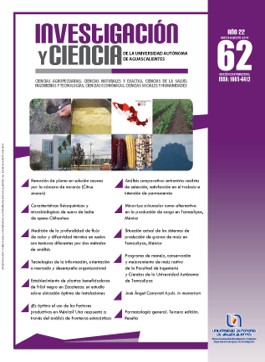Arbuscular mycorrhizal as alternative in sorghum production in Tamaulipas, Mexico
DOI:
https://doi.org/10.33064/iycuaa2014623636Keywords:
microbial inoculants, Sorghum bicolor, agronomic practicesAbstract
Tamaulipas occupies the largest area of planting of sorghum in Mexico, mostly as monoculture and presents critical productivity. Microbial inoculation or biofertilization is a practice that promotes sustainable agriculture. We describe some of the results of studies conducted mainly with mycorrhizal inoculation in sorghum in Tamaulipas. With Rhizophagus intraradices (mycorrhiza INIFAP) symbiosis, originated increased production of sorghum in two soil textures. The productivity of sorghum with R. intraradices
or Asospirillum brasilense individually inoculated was superior to the co-inoculation of both. For five consecutive years the yield of R. intraradices was equaled to chemical fertilization (60-20-00); after five years, mycorrhizal fungus increased the biological activity of soil, without altering the chemical properties of the same. We identified the effectiveness of some native microbial strains in sorghum productivity.
Downloads
References
• OLALDE, P. V. y SERRATOS, R. Biofertilizantes: Micorrizas y bacterias promotoras de crecimiento. En: A DÍAZ F y N MAYEK P (Eds.), La Biofertilización como Tecnología Sostenible, pp: 55-66, México: Plaza y Valdés/CONACYT, 2008.
• OSONUBI, O. Comparative effects of vesicular-arbuscular mycorrhizal inoculation and phosphorus fertilization on growth and phosphorus uptake of maize and sorghum plants under drought-stressed conditions. Biol. Fert. Soils, 18: 55-59, 1994.
• PEÑA DEL RÍO, A. et al. Aislamiento e identificación de hongos micorrízicos arbusculares de la región semiárida de Tamaulipas, México. Libro II Foro Internacional Biológico Agropecuario. Universidad Veracruzana, Tuxpan, Veracruz, pp: 468-476, 2007.
• PLENCHETTE, C. et al. Managing arbuscular mycorrhizal fungi in cropping systems. Canadian Journal of Plant Science, 85: 31-40, 2005.
• ROBLES, C. y BAERA, M. J. Respuesta de la planta y del suelo a inoculación con Glomus intraradices y rizobacterias en maíz en cultivo intensivo. Terra Latinoamericana 22: 59-69, 2004.
• RODRÍGUEZ, Y. Y. et al. Estudio comparativo de seis cepas de hongos micorrízicos arbusculares en su interacción con el tomate (Lycopersicun esculentum). Ecología Aplicada, 3: 162-171, 2004.
• ROLDÁN, A. et al. Soil sustainability indicators following conservation tillage practices under subtropical maize and bean crops. Soil Tillage Research, 93: 273-282, 2006.
• RUSSO, M. V. y PERKINS, V. P. Yield and nutrient content of bell pepper pods from plants developed from seedlings inoculated, or not, with microorganism. HortScience, 45: 352-358, 2010.
• SAINI, V. K. et al. Comparison of crop yield, soil microbial C, N and P, N-fixation, nodulation and mycorrhizal infection in inoculated and non-inoculated sorghum and chickpea crops. Field Crops Research, 89: 39-47, 2004.
• SAIRAM, R. K. Effect of homobrassinolide application on plat metabolism and grain yield under irrigated and moisture-stress
conditions of two wheat varieties. Journal of Plant Growth Regulators, 14: 173-181, 1994.
• SALINAS, G. J. et al. Efectos de labranza y biofertilización en propiedades del suelo que afectan a la sostenibilidad de la producción de frijol. Ciencia y Tecnología Alimentaria, 5: 30-34, 2005.
• SARING, S. et al. Improvement of the water status and yield of field-grown grain sorghum (Sorghum bicolor) by inoculation with Azospirillum brasilense. Journal of Agriculture Science, 110: 271-277, 1988.
• SASSE, J. Recent progress in brassinoesteroids research. Physiological Plant, 100: 697-701, 1997.
• SHARMA, S. et al. Impact of application of biofertilizers on soil structure and resident microbial community structure and function. En: MAHESHWARI, D.K. (Ed.), Bacteria in Agrobiology: Plant Probiotics, pp.65-79, New Delhi: Hauz Khas, 2012.
• SINGH, M. y TILAK, K. Inoculation of sorghum (Sorghum bicolor) with Glomus versiforme under field conditions. Tropical Agriculture, 69: 323-326, 1992.
• SMITH, S. E. y READ, D. J. Mycorrhizal Simbiosis. 3 ed., New York, USA: Academic Press, 2008.
• SYLVIA, D. M. et al. Field response of maize to VAM fungus and water management. Agronomy Journal, 25: 193-198, 1993.
• TARAFDAR, J. C. y RAO, V. A. Response of arid legumes to VAM fungal inoculation. Symbiosis, 22: 265-274, 1997.
• TCHABI, A. et al. Efficacy of indigenous arbuscular mucorrhizal fungi for promoting white yeam (Dioscorea rotundata) growth
in West Africa. Applied Soil Ecology, 45: 92-100, 2010.
• UTRIA, B. et al. Respuesta de plántulas de cafeto a la aplicación de brasinoesteroide en diferentes concentraciones y épocas de su desarrollo. Revista Chapingo Serie Hortícola, 10: 11-14, 2004.
• VARELA, L. y TREJO, D. Los hongos micorrizógenos arbusculares como componentes de la biodiversidad del suelo en México. Acta Zoológica Mexicana, 1: 39-51, 2001.
• VASSEY, J. K. Plant growth promoting rhizobacteria as biofertilizers. Plant and Soil, 255: 571-586, 2003.
• VELASCO, U. L. et al. Vermicomposta, micorriza arbuscular y Azospirillum brasilense en tomate de cáscara. Terra, 19: 241-248, 2001.
• VIVAS, L. et al. Insecticide thiamethoxam 25 % for the control of the sogata insect in rice. Agronomía Tropical, 59: 89-98, 2009.
• WANI, S. P. y LEE, K. Biofertilizers for sustaining cereal crops production. En: KANNAIYAN, S. (Ed.), Biotechology of Biofertilizers, pp: 50-64, India: Narosa Publishing, 2002.
• WIDADA, J. et al. The interactive effects of arbuscular mycorrhizal fungi and rhizobacteria on the growth and nutrients uptake of sorghum in acid soil. En: VELÁZQUEZ, E. Y RODRÍGUEZ, B. (Eds.), First International Meeting on Microbial Phosphate Solubilization, pp. 173-177, 2007.
• WILLIAMS, A. H. et al. Sorgo. En: RODRÍGUEZ DEL BOSQUE, L. (Ed.), Campo Experimental Río Bravo: 50 Años de Investigación Agropecuaria en el Norte de Tamaulipas. Libro Técnico No. 1. Río Bravo, Tamaulipas, México: Campo Experimental Río Bravo, INIFAP. 287 pp., 2006.
De páginas electrónicas
• ADESEMOYE, A. O. et al. Plant growth promoting rhizobacteria allow reduced application rates of chemical fertilizers. Microbiological Ecology, 2009. doi: 10.1007/s00248-009-9531-y.
• GOBIERNO DEL ESTADO DE TAMAULIPAS De: www.agrotamaulipas.gob.mx/información/sector/agricultura.htm.2010. ene. 2010.
Downloads
Published
How to Cite
License
Copyright (c) 2014 Arturo Díaz Franco, Héctor Manuel Cortinas Escobar, Juan Valadez Gutiérrez, María de los Ángeles Peña del Río

This work is licensed under a Creative Commons Attribution-NonCommercial-ShareAlike 4.0 International License.
Las obras publicadas en versión electrónica de la revista están bajo la licencia Creative Commons Atribución-NoComercial-CompartirIgual 4.0 Internacional (CC BY-NC-SA 4.0)









